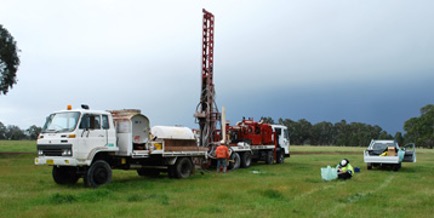Nagambie Resources (ASX: NAG) has declared the C1 mineralisation at the Nagambie Mine in Victoria, Australia an antimony-gold, Costerfield-Mine-style discovery following the receipt of the latest assays from the 2022 drilling programme.
The first eight waste-diluted intersections within the C1 vein-system mineralisation outlined to date average 7.4% antimony (Sb), 3.0 g/t gold (Au) and 20.5 g/t gold equivalent (AuEq).
The average of 7.4% Sb is extremely encouraging, being two to three times the mined antimony grade of the nearby Costerfield Mine (currently Australia’s only and highest-grade antimony mine and Victoria’s second-most profitable gold mine).
The average of 20.5 g/t AuEq to date is 6.8 times the estimated mineable cut-off grade (MCOG) of 3.0 g/t AuEq. This indicates potentially very-low operating cost, very-high operating margin mineralisation. The C1 mineralisation commences from the base of oxidation, at around 50m vertical depth, within Nagambie’s existing mining licence, MIN5412.
Decline access to the mineralisation could commence adjacent to the treatment plant being constructed by Golden Camel Mining (GCM) under a joint venture with Nagambie (GCM to pay 100% of all construction and commissioning costs with net operating cash flow after commissioning shared 50:50).
The C1 mineralisation is currently known to extend, based on diamond core logging, to approximately 230m vertical depth, with drilling at depth and to the north continuing apace.
Four stibnite (antimony sulphide, SbշSӡ) veins are now identified within the C1 vein system. These could be easily stopeable, given their steep dip, as individual or multiple veins, depending on the widths of the uneconomic material between the veins. Estimated horizontal thickness (EHT) for each potential stope is currently between 1.2m and 4.7m. With typically two stopes per level, total C1 stoping thickness per level would be variable, currently up to 5.9m EHT.
All intersections (potential stopes) of the C1 mineralisation to date that average the MCOG of 3.0 g/t AuEq or greater, have an EHT of 1.2m or greater (after waste dilution is added if required), and that have an Sb grade of 1.0% or greater (indicating significant antimony-gold veining) are summarised in Table 1. Previously reported intersections are indicated as (PR).
“In late February this year, we reviewed the 2006 NRP02 intersection under the West Pit,” Executive Chairman, Mike Trumbull, said.
“The principal conclusion at that time was that the high-grade, antimony-gold veining could strike NNW, a direction never tested in the eight follow-up holes that were drilled in 2006/2007.
“Importantly, it was noted that NNW is a common strike direction for the antimony-gold veins at the Costerfield Mine, 45 km to the west of the Nagambie Mine.
“Nagambie started the 2022 antimony-gold veins drilling program in April and seven months later we have solved the NRP02 riddle and announced the discovery of the C1 (as in Costerfield-Mine-style) mineralisation, having already tracked it between 50m and 230m vertical depth.
“The average grade for the first eight intersections (potential stopes) indicates that grade in the early years of an operation could be a big multiple of MCOG and the grade-depth profiles at both the epizonal Costerfield and Fosterville Mines indicate that grade could also increase with depth at the epizonal Nagambie Mine. In narrow- vein gold mining, and antimony mining, ‘grade is king’.
“Another plus in my experience is that mine planning for the virginal C1 vein system, and the other C-vein systems that could be discovered further to the west, won’t have to consider any historic underground openings and the pumping and treatment of the water in those openings.
“Nagambie has now established the approximate southern limit of the NNW-plunging C1 vein system and will continue to drill down plunge, together with some infill holes, to gain greater definition of the system. Importantly, we are currently expanding the very-high-grade C1 mineralisation at a drilling cost of around only A$10 per ounce gold equivalent versus a potential operating margin of over A$2,000 per ounce (based on a current gold price of around A$2,600 per ounce, an average grade of 20.5 g/t AuEq to date, and a MCOG of 3.0 g/t AuEq).
“In the first half of CY2023, it is planned to design an exploration decline and associated underground development to access the C1 mineralisation at around 100m vertical depth and enable strike driving of the antimony-gold veins on multiple levels.”
For further information please visit: https://www.nagambieresources.com.au/












